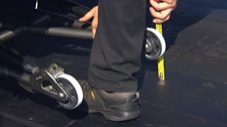NHRA Tech Talk with Bruno: Why Crews Adjust the Wheelie Bars on Pro Stock Cars

Pro Stock has and likely always will be my favorite class in all of drag racing, and NHRA’s Bruno Massel had a great Tech Talk segment posted on the sanction’s Facebook on Tuesday about a small, but vitally important procedure that each team does before every single pass down the track.
While Top Fuel dragsters and Funny Cars rely on wheelie bars just like Pro Stock, those bars are generally set in the pit and only adjusted occasionally when needed. On any given pass in the nitro classes, the wheelie bar may not even touch the ground. In Pro Stock, however, the wheelie bar plays an integral part in keeping the car in the center of the groove through the launch sequence, a crucial section of the track for Pro Stock, perhaps more than any other class.
Pro Stockers are manually shifted and keep the front wheels in the air halfway through second gear, meaning for the first 80 feet or so of the 1,320, the wheelie bar is literally the only thing steering the car. With such an important role to play in each run, the wheelie bars have to be adjusted very precisely just before the car stages.
There are a couple of reasons they do it on the starting line instead of in staging or back in the pit area. As Massel points out, each track has it’s own characteristics, so the car being moved over even a couple of inches can cause a small change in the clearance between the wheelie bar and the track. Another reason they have to be adjusted after the burnout is the minute differences in the tire height before and after the driver does his burnout.
With the tire cool before pulling into the bleach box, the tire pressure is set with an ultra-precise tire gauge. After the burnout, the tire pressure will be higher due to the increased temperature of the air inside, causing the rear of the car to sit slightly higher than before the burnout. This means the wheelie bars would also ride a bit higher, changing the way the car behaves upon the driver dumping the clutch.
Massel also points out that the right side is about 3/4 of an inch higher due to the torque of the car flexing the chassis, just another small detail to show how precise these adjustments have to be to ensure these cars make clean runs!
https://www.facebook.com/NHRA/videos/10156634926971410/

